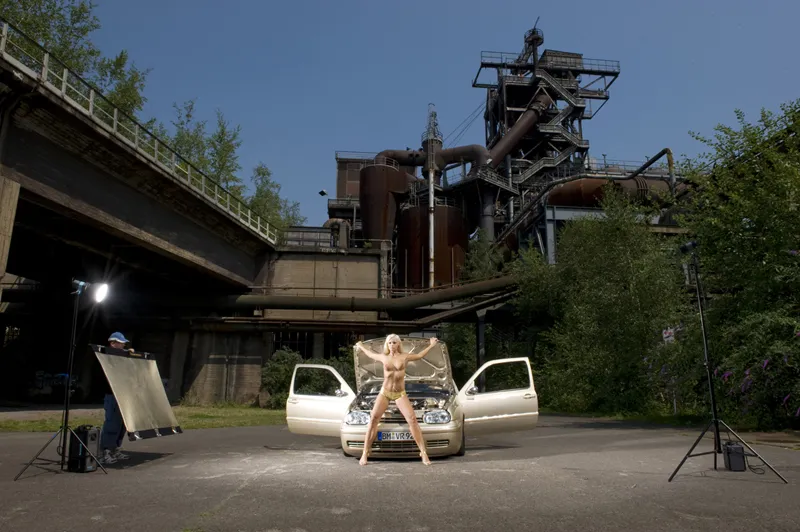How do I complete my first photo job professionally, efficiently, financially successfully and legally securely?
Preparing an offer
You should never define yourself by price alone, but always by the quality of your photographic work! In this respect, it is your price-performance ratio that must be right and should be the deciding factor in getting a job! In addition, it's damn hard or almost impossible to get away from a low price level and raise prices again.
If an offered fee seems too low to me, I sometimes turn down a photo assignment. My time is simply far too valuable to do a low-paid job, because I can do much better photographing freelance work in the meantime.
The submission of an offer is not bound to a certain form. An email with the text "Hello Mr. XY, I would photograph the 10 products as described by you for the price of 800 euros plus VAT" is perfectly sufficient to be legally binding. However, it is always better to make the offer as specific as possible so that you don't get into a dispute with the customer later if they have a different idea of how the task should be carried out than you do. So write the offer in as much detail as possible, even if you have to repeat the customer's list of requirements.
If travel expenses are incurred during the execution of the photo assignment, these should be listed in the quote (in the estimated amount). However, whether your customer will accept a Rolls-Royce as a rental car is rather questionable ...
As a rule, a quotation should include
- Name, address and legal form of the service recipient (the client)
- Date of the offer, possibly with an indication of how long you feel bound by this offer
- Offer number
- Number of preparation and shooting days
- Task definition
- Planned date
- Estimated costs for assistants, models, make-up artists, etc.
- Scope of the photos you provide to the customer
- Scope of the rights of use granted by you
- the technology used by you
- agreed tasks (scope) of the post production work you have carried out
- Travel costs (for models, etc.)
- Costs for catering
- Information on payment terms (with exact date)
- Note "The use of the photographs is only possible after full payment has been made."
- Note: "The prices are net prices, the statutory VAT must be added."
- Note: "Further costs incurred, such as costs for express delivery, etc., will be invoiced to the client based on receipts."
- Flat rate for travel and overnight stay(s) or reference to the expected travel and accommodation costs - your bank details
- your VAT ID
- agreed advance payment (if an advance payment has been agreed).
In the offer, you should write down everything you were able to find out from the customer about the planned photo shoot. This information is used for coordination so that neither side has different ideas (e.g. about the type of photography or the scope) than the other. In this photo series of a data center, playing with blurring was an essential part of my image idea, which I had also communicated to the customer accordingly in the offer.
If the photos are not taken for private individuals but are to be used commercially by the client, the photographer's main service is no longer the production of (often several thousand) photos, but the granting of rights of use. The photographer "permits" the customer to use the photos he has taken to a certain extent and for certain purposes.
The rights of use are granted according to material, spatial and temporal aspects:
- Factual differentiation: " What may the customer use the photos for?" Possible factual uses would be, for example: for internet store, for company brochure, for trade fair poster, for newspaper advertisement, for advertising poster, for product packaging, etc.
- Spatial differentiation: " Where, in which area, may the customer use the photos?" Possible geographical uses would be, for example: in Düsseldorf, in NRW, in West Germany, in Germany, in Germany and Austria, in Europe, worldwide, etc.
- Temporal differentiation: " How long may the customer use the photos?" Possible temporal uses would be, for example: on 24.12.2011, in December 2011, for 3 months, for 1 year, for 5 years, etc.
The usage rights scheme can be used to write excellent offers; it is a great calculation aid, because it allows differentiations that were previously not possible when calculating according to time expenditure as usual.
Example: You receive a phone call. You are asked to photograph the caller's girlfriend in her underwear. The caller wants black and white photos, the shoot should take 4 hours. The caller accepts your offer to do the shoot for 300 euros (gross). The next day is the shoot, the photos are great, the model gets all your photos on DVD. A week later you get a second call. The caller is a friend of the first caller and also the marketing manager of a major underwear manufacturer. You've already guessed it: he liked the photos and now he wants you to photograph a model provided by the company (and already made up on the day of the shoot) in underwear, in black and white and for a period of 4 hours. When asked about your fee expectations, you answer off the top of your head: 1,200 euros plus VAT. The marketing manager is horrified; his friend had told him about shooting costs of 300 euros gross.
How do you explain the difference to the marketing manager? The answer is quite simple: a private individual only shows the photos around to friends at best. They are not allowed to publish the photos, not even on the Internet, unless this has been expressly agreed. An underwear manufacturer uses the photos for advertising in magazines and product catalogs, for product packaging, etc. The photos are therefore used to a considerable extent. The photos are therefore published to a considerable extent. This also justifies the higher price for the same photographic service and the same time expenditure. In this case, you would therefore have to ask about the planned scope of the publication in terms of subject matter, space and time before you can submit an offer. You can then prepare a quote tailored precisely to the planned publications.
When calculating an offer, it is not important how long the shoot is expected to take, because then an underwear manufacturer who wants to use the photos for advertising would have to pay just as little as a private customer if both shoots took the same amount of time. The decisive factor is the extent to which the photos are later used, i.e. published.
The book "Bildhonorare" by the Mittelstandsgemeinschaft Foto Marketing (MFM), published by the Bundesverband der Pressebild-Agenturen und Bildarchive e.V. (BVPA), is a very good aid for preparing quotations according to this calculation scheme. It costs (together with the handbook "Der Bildermarkt") 33,- Euro.
Confirmation letter
If you have been commissioned by your customer (verbally or in writing), you should summarize the order in detail and send it to your customer again as a letter of confirmation, preferably by fax or registered mail. The purpose of this letter is to clarify any ambiguities and to reiterate to the client the conditions under which you will be working. While there is often quick agreement on the key data of an order, the devil is literally hidden in the detail.
There are often many inconsistencies lurking in the small print (i.e. in the general terms and conditions), which is why this confirmation letter serves to inform your customer once again about the content of your general terms and conditions and at the same time make them part of the contract. Key points in the T&Cs may include: the procedure in the event of late payment, the customer's obligation to inspect the photos after receipt, the period for complaints, options for rectification, arbitration procedures, return of originals/data carriers, image retouching, etc.
Processing
The photo job should run smoothly, effectively ("do right things") and efficiently ("do things right"). To ensure this, you should not be too short of time. It is also advisable to have at least one or more assistants with you, even if you are used to working alone. Not only to help you set up the flash system or the set, but also so that someone can be sent out to get a missing prop, the catering, a suitable outfit, etc. if necessary.
Even if you are more of a chaotic type and prefer to do 25 things at once, a structured approach will help you to handle jobs so that you don't lose track and can work efficiently. Assistants can help to take small tasks off your hands so that you can concentrate on the important things - taking photos and working with the client.
In contrast to many of my colleagues, I have always found it enriching when the clients were personally present on set during the photo shoot. This ensures that the client's interests are realized photographically by me. At the same time, the presence of the client or an authorized representative prevents the client from complaining about the photoshoot, because if I take photos according to the instructions of the authorized representative present, I cannot be held liable later if the client does not like the results.
The prerequisite is, of course, that I regularly present the authorized representative with the digital results - as an interim status, so to speak - preferably on a computer monitor, and that I implement his instructions or suggestions for improvement.
If none of the client's employees are present at the shoot, it's certainly not a bad idea to send photo results to the client by email a few times in between so that they can check the progress of the photo shoot and "approve" what has been achieved so far. Should something unforeseen happen, it's always good if you can reach the client by phone at short notice. So make sure you have your client's cell phone number just in case.
At the end of the shoot, you will need to view the photos before you send them to the client. The personal inspection by the photographer serves to identify any errors, because nothing is more embarrassing than if your customer calls and finds errors while you are still unaware.
Always make 1-2 data backups on external hard disks before you send the results to your customer. Simply putting the original memory cards in an envelope and sending it to the customer by post is not an option!
It would be a shame if the results of a commissioned shoot were lost. So always make enough backup copies!
The client will often be present at the shoot and will also bring their own laptop. In this case, he will be eagerly awaiting the exchange of your full memory card for an empty one so that he can load and view the photos on his computer promptly and during the shoot.
Invoicing
Invoices with an invoice amount of 100 euros or more must meet the following requirements in order to be recognized by the tax office. If the invoice does not meet the requirements, your customer may - rightly! - refuse to pay it. If he pays it anyway, his tax office may not grant him the input tax deduction or may not recognize the deductibility of the entire invoice amount. And the same applies to you: Before you pay an invoice from a vendor, make sure the following points are present:
- The term "invoice"
- Full name and address of the invoice and service recipient
- Your name and address (address of the invoice issuer; can also be the address of the business premises)
- your tax or alternatively VAT identification number
- Invoice date (date of issue)
- Invoice number (this must be assigned consecutively and must be unique; a specific format does not have to be adhered to)
- Service provided (quantity and type of goods supplied or the scope and type of other service)
- delivery date (if necessary, use the standard wording "delivery date is invoice date" if no separate delivery date can be specified)
- the remuneration for the photographic service broken down by tax rates
- the VAT rate to be applied to this (unless you are a "small business for VAT purposes"; see below)
- the resulting VAT amount
- Total invoice amount (recommended, but not required by law)
- Bank details of the issuer (recommended, but not required by law)
- Payment term (recommended, but not required by law).
For photographers, it is also advisable to state the scope of the rights of use granted in writing on the invoice. Just as a reminder. In this way, no misunderstandings can arise for the customer.
The net amounts of the individual invoice items are listed, followed by the total VAT due and the total gross amount as the payable invoice total. If a payment term was agreed in the offer or during the contract negotiations, it is customary to state this again on the invoice.
If you are a small VAT entrepreneur in accordance with Section 19 UStG (if your annual turnover was less than EUR 17,500 in the previous year and is not expected to exceed EUR 50,000 in the current year), i.e. you are exempt from paying VAT to the tax office, you simply show the amounts of the individual items and the total amount. According to the legal text, VAT is included in these items; it just does not need to be shown or paid to the tax office.
Dunning system
Let's hope your customers pay on time! Unfortunately, it happens often enough that invoices are not paid. There can be various reasons for this. Some companies generally pay their invoices several months late, which leads to interest gains. Others would like to, but are unable to pay, for example because they are short of cash themselves. Many are themselves waiting for a payment to be received, for example from the tax office for a tax refund. Others, on the other hand, try to avoid paying the invoice amount at all or only pay a reduced amount by complaining about alleged errors in the photographic work.
If your customer does not pay the invoice on time, you should not immediately threaten to use the Stocker. Maybe the invoice really did get lost in the paperwork. First ask politely what caused the late payment. If payment is still not made, set a reasonable deadline (2-3 weeks) after which you should go to a lawyer.
As a general rule, invoices are due immediately unless otherwise agreed. If your customer does not pay on time, they do not have to be sent a reminder in order to be in default; they are automatically in default if the deadline is exceeded. To be able to prove that your customer has received the invoice, it is therefore advisable to send it again by fax in addition to the original. Or by registered mail. However, this is not very stylish if you suspect in advance that the customer does not want to pay.
If the customer has not paid by the deadline, in practice you will wait another 1-2 weeks before politely asking why the invoice has not yet been paid. If you now realize that payment has not yet been made on purpose, you would send a reminder after another week has passed, requesting immediate payment of the outstanding amount. Any reminder costs incurred (these must be realistic, so should be in the region of €3 to €5) and overdraft interest may be charged separately.
Overdraft interest is charged at a rate of 5% (p.a.) above the prime rate of the European Central Bank (ECB).
After an unsuccessful reminder, you should now consult a lawyer who will collect your debt - in court if necessary. The costs incurred for this must be borne by the debtor, i.e. your customer, unless it turns out that he had a justified reason for refusing payment, which is virtually impossible if you have supplied usable photos of "average type and quality".


